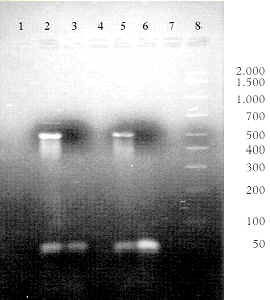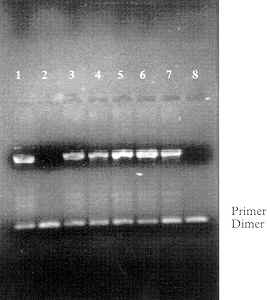TechNote Volume 3 No. 19 - NucleoLink and TopYield Strips as Traditional Amplification Tubes in Commercial Thermal Cyclers
NucleoLink and TopYield Strips as Traditional Amplification Tubes in Commercial Thermal Cyclers
The studies on the standard DNA template amplification presented in this TechNote on NucleoLink™ (Cat.No. 248259) and TopYield™ (Cat.No. 248909) strips unequivocally demonstrate the utility of these strips as standard reaction vessels despite built-in differences in resin, surfaces and format. The NucleoLink™ strips are designed to conduct solid phase polymerase chain reaction (PCR) and continue in the same vessel to detection either by calorimetric or fluorescence analysis. Although the TopYield™ strips are designed specifically for solution phase amplification, both the NucleoLink™ and the TopYield™ strips support solution phase amplification of nucleic acids. The experiments were designed to demonstrate the utility of both the NucleoLink™ and TopYield™ strips as standard reaction vessels. Specifically, control DNA template and primer sets from the Perkin Elmer and the Life Technologies, Inc. PCR reagent systems were amplified in the Perkin Elmer 9600 thermal cycler (  ). With each template-primer system, the DNA template was found to be appropriately amplified in both the TopYield™ and NucleoLink™ strips.
). With each template-primer system, the DNA template was found to be appropriately amplified in both the TopYield™ and NucleoLink™ strips.
Materials and Methods
Fifty microliters of reaction mix containing reactants specified by the manufacturers were aliquoted in the specified wells of the NucleoLink™ and TopYield™ strips. The Perkin Elmer lambda DNA combination template-primer reagents were used exactly as specified in the GeneAmp PCR Reagent Kit with AmpliTaq DNA Polymerase (Cat. No. N801-0055) for the amplification of a 500 bp lambda genomic DNA segment. In the case of Life Technologies, Inc., a DNA-primer set specific for the amplification of a 764-bp fragment, encoding a single copy gene of the brain-derived neurotrophic factor, was tested as described in the GIBCO BRL PCR Reagent System (Cat. No. 10198-018). A portion of the bovine leukemia virus (BLV) (  ) cloned into the pGEM 3Z vector from Promega (Rasmussen et al, Clin. Chem 40/2, 200-205, 1994) was utilized for solution phase amplification in the NucleoLink™ and TopYield™ strips. In each case, the filled strips were sealed first with GeNunc™ tape (Nunc Cat.No. 232689), then overlaid with a silicone rubber pad 72 x 120 mm in size and 3 mm thick. The thermal cycler was programmed for a total of 40 cycles. Each cycle consisted of three set points: 94ºC for 30 sec, 55ºC for 30 sec and 72ºC for 30 see with a 5 minute pause at 94ºC at the end of the initial set point in the first cycle. These forty cycles were followed by a hold of 72ºC for 10 minutes followed by a 4ºC hold for an indefinite period.
) cloned into the pGEM 3Z vector from Promega (Rasmussen et al, Clin. Chem 40/2, 200-205, 1994) was utilized for solution phase amplification in the NucleoLink™ and TopYield™ strips. In each case, the filled strips were sealed first with GeNunc™ tape (Nunc Cat.No. 232689), then overlaid with a silicone rubber pad 72 x 120 mm in size and 3 mm thick. The thermal cycler was programmed for a total of 40 cycles. Each cycle consisted of three set points: 94ºC for 30 sec, 55ºC for 30 sec and 72ºC for 30 see with a 5 minute pause at 94ºC at the end of the initial set point in the first cycle. These forty cycles were followed by a hold of 72ºC for 10 minutes followed by a 4ºC hold for an indefinite period.
Results and Discussion
 With both the NucleoLink™ and TopYield™ strips, an appropriately sized 500 base pair product was amplifiable with the lambda DNA controls when thermocycled in the Perkin Elmer 9600 thermal cycler. The positive amplification in strips placed throughout the block indicated unequivocal performance: i.e., proper heat transfer was achieved in all randomly tested wells. In addition, data on the DNA positive and negative wells, C4 and B4 in the TopYield™ strip and E8 and F8 wells in the NucleoLink™ strip, as seen in Figure 1, demonstrate that no cross-contamination was evident in the strip well format. With both the NucleoLink™ and TopYield™ strips, an appropriately sized 500 base pair product was amplifiable with the lambda DNA controls when thermocycled in the Perkin Elmer 9600 thermal cycler. The positive amplification in strips placed throughout the block indicated unequivocal performance: i.e., proper heat transfer was achieved in all randomly tested wells. In addition, data on the DNA positive and negative wells, C4 and B4 in the TopYield™ strip and E8 and F8 wells in the NucleoLink™ strip, as seen in Figure 1, demonstrate that no cross-contamination was evident in the strip well format.
| Lanes | 1 | 2 | 3 | 4 | 5 | 6 | 7 | 8 | | Modules | | TopYield™ | | NucleoLink™ | | | | | | C4 | B4 | | E8 | F8 | | | | | | + | – | | + | – | | Mol. Wt. Marker | | Thermal Cycler | | Perkin elmer 9000 | |
 Amplification of an appropriately sized 764 base pair fragment from a single copy gene of the brain derived growth factor from the GIBCO BRL PCR Reagent System in the NucleoLink™ and TopYield™ strips was achieved with equal success. As demonstrated in Figure 2, no cross-contamination of DNA template was evident between wells A12 and B12 when DNA template was added to well A12 but left out of the well B12. Amplification of an appropriately sized 764 base pair fragment from a single copy gene of the brain derived growth factor from the GIBCO BRL PCR Reagent System in the NucleoLink™ and TopYield™ strips was achieved with equal success. As demonstrated in Figure 2, no cross-contamination of DNA template was evident between wells A12 and B12 when DNA template was added to well A12 but left out of the well B12.
Data on the amplification of the bovine leukemia virus fragment carried out in the Perkin Elmer 9600 thermal cycler also confirmed that both the NucleoLink™ and the TopYield™ strips are fully functional as traditional amplification reaction vessels.
| Lanes | 1 | 2 | 3 | 4 | 5 | 6 | 7 | 8 | | Modules | TopYield™ | NucleoLink™ | TopYield™ | NucleoLink™ | | | B1 | G1 | A4 | D4 | C8 | H8 | A12 | B12 | | | + | – | + | + | + | + | + | – | | Thermal Cycler | | Perkin elmer 9000 | |
 With both the NucleoLink™ and TopYield™ strips, an appropriately sized 500 base pair product was amplifiable with the lambda DNA controls when thermocycled in the Perkin Elmer 9600 thermal cycler. The positive amplification in strips placed throughout the block indicated unequivocal performance: i.e., proper heat transfer was achieved in all randomly tested wells. In addition, data on the DNA positive and negative wells, C4 and B4 in the TopYield™ strip and E8 and F8 wells in the NucleoLink™ strip, as seen in Figure 1, demonstrate that no cross-contamination was evident in the strip well format.
With both the NucleoLink™ and TopYield™ strips, an appropriately sized 500 base pair product was amplifiable with the lambda DNA controls when thermocycled in the Perkin Elmer 9600 thermal cycler. The positive amplification in strips placed throughout the block indicated unequivocal performance: i.e., proper heat transfer was achieved in all randomly tested wells. In addition, data on the DNA positive and negative wells, C4 and B4 in the TopYield™ strip and E8 and F8 wells in the NucleoLink™ strip, as seen in Figure 1, demonstrate that no cross-contamination was evident in the strip well format. Amplification of an appropriately sized 764 base pair fragment from a single copy gene of the brain derived growth factor from the GIBCO BRL PCR Reagent System in the NucleoLink™ and TopYield™ strips was achieved with equal success. As demonstrated in Figure 2, no cross-contamination of DNA template was evident between wells A12 and B12 when DNA template was added to well A12 but left out of the well B12.
Amplification of an appropriately sized 764 base pair fragment from a single copy gene of the brain derived growth factor from the GIBCO BRL PCR Reagent System in the NucleoLink™ and TopYield™ strips was achieved with equal success. As demonstrated in Figure 2, no cross-contamination of DNA template was evident between wells A12 and B12 when DNA template was added to well A12 but left out of the well B12.